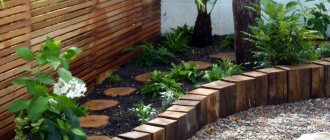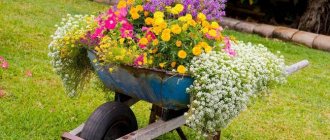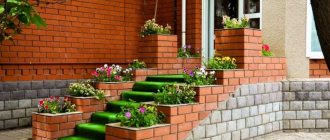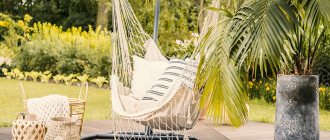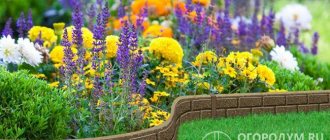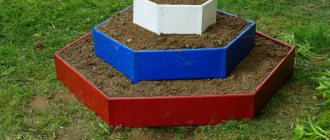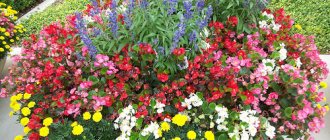Hedge
It is not necessary to build a fence; it can be easily grown from special plants. The simplest option is a low hedge, trimmed into neat blocks or a rounded line. You can put a colorful ribbon of flowers under the hedge.
The strict geometry of such a border harmonizes perfectly with monoflower beds and garden paths made of pebbles. Artistic disorder and naturalness are also a good idea; fences made of lush, bright thickets look great.
Stone
We are unlikely to be mistaken if we call natural stone the true king of landscapes. It is easy to lay out a border for a flower bed from approximately identical rectangular cobblestones by simply pressing them into the ground or stacking them on top of each other.
There is nothing easier than collecting round pebbles of different sizes and shapes and placing them in a chaotic manner on the border of the flowerbed. It is not necessary to form a continuous line; the boulders will look great in scattered groups.
You can also imitate a stone stream “flowing” from a large overturned pot.
From flat cobblestones and fragments you can build entire multi-tiered compositions with borders, at the same time laying footpaths from stone slabs. But this process is very labor-intensive, and a lot of natural materials will be needed.
It is much easier to purchase ready-made paving slabs and use them to limit the flower bed. The smaller the fragments, the more complex and smooth the line you can create. A wide embankment of crushed stone will look beautiful next to such a border.
The same crushed stone or pebbles, plain or multi-colored, can be folded inside a wire frame and constructed a high border for a flower bed of any shape.
Concrete blocks
It is not easy to get a sufficient amount of natural stone; it is much easier to build a border for a flower bed from leftover building materials. It’s a great idea to use concrete blocks; colored and shaped ones look especially good.
But even from ordinary rectangular blocks you can build an original fence, making it multi-tiered, chaotic, or painted in different colors. The main advantage of block borders is the ability to plant plants right inside, which looks very impressive.
Requirements
The edging should be made of decorative bright material. It must be selected taking into account the plants planted in the flowerbed. There are rules for decorating flower beds with borders:
- Environmental friendliness. It is not recommended to choose a material that can release toxic substances, especially when heated. This applies to some plastic products. During periods of summer heat, it is capable of releasing harmful fumes.
- Strength. The fence should not be destroyed by accidental impact or ground pressure.
- Economical. It is advisable to use durable and expensive materials for flower beds of perennials. If the flower garden is located temporarily or is planted with annual plants, then you can limit yourself to available items for protection.
Avoid materials that get very hot in the sun. This process can cause burns to plants and dry out the soil.
Tiles and mosaics
The blocks can be additionally decorated with mosaics. To do this, they are covered with mortar, shards of tiles or pieces of colored glass are pressed into it and wait for it to harden.
Or you can simply lay out the border for the flower bed with interesting tiles, purchased specifically for this purpose or left over after renovation.
Brick
Now let's turn to the brick. Many owners of self-built private houses still have it in stock, and then it would be an excellent solution to build brick borders for flower beds.
It is not necessary to build a monumental wall; symbolic barriers made of bricks stacked in one line or dug into the ground at an angle also look decent.
Slate and corrugated board
Concluding the topic of construction residues, let’s remember roofing materials and metal sheets. If you have tiles or slates lying around, simply dig these fragments into the ground to the desired depth. It is better to additionally strengthen high slate borders for flower beds from the outside.
Unused corrugated sheeting after erecting a fence on the site can be cut into pieces and also dug into the soil along the border of the flower bed. And if you need to make high flower beds, it is better to strengthen the borders, for example, with a wire frame.
What it is?
Translated from French, border means edge, edge or frame. This element serves to separate the flower garden area from the total area of the site, while simultaneously decorating it and protecting it.
Why do you need a flower garden fence?
Garden borders have several important functions. The main one is protection from soil spillage and preservation of the flower garden. In addition, fencing around the flower bed brings many practical benefits. The purpose of the curbs is :
ensuring accuracy and rationality of watering;- limiting the growth and movement of weeds;
- maintaining the location and outline of the flower bed;
- protection of cultivated plants from damage and trampling;
- obstacle to the movement of pests;
- visual division of the site into zones;
- raising the soil level above the ground;
- completion of the flowerbed composition;
- making it easier to care for plants.
In order for the curb to fully fulfill its purpose, it must be properly arranged.
Boards and bars
Let's move on to wood and start with the most obvious solution - putting together a fence from thin boards or massive bars.
The boards do not need to be nailed together; they can be connected with metal corners, similar to door hinges. This technique allows you to bend the wood and create rounded barriers. Designs can be multi-tiered, complemented by mesh or decorative lamps.
You can simply limit the green spaces with a fence made of painted or freshly planed boards, which can have different heights, frequencies and shapes of teeth.
Heavy bars look especially advantageous when driven into the ground along the edge of a flowerbed to an unequal depth, but single-level wooden borders for flowerbeds are also a good solution.
Metal: Durable
Metal borders are especially suitable as fencing for areas where there are forged elements in the design of the house and surrounding area. This could be elegant wrought iron bars on windows, lanterns, railings on stairs or an external fence.
Openwork metal patterns will not serve as an obstacle to viewing all the beauty of the flower garden. The metal structures themselves, despite their apparent elegance, are quite heavy.
A low metal fence made by casting can have different shapes Source actionquarterly.com
There are the following types of fences:
- welded;
- cast;
- forged.
Welded fences differ from cast and forged ones in simpler shapes. Graceful, equipped with curved elements and ornaments, fences are made by forging and casting. Such structures can serve as a basis for climbing plants. In addition to the fences, you can install metal arches for wickerwork in the same style.
On a note! The metal must be pre-treated with anti-corrosion substances.
Logs and stakes
Continuing the theme of logs, we will cut off identical side fragments from them and line them up on the border of the flowerbed. The bark can be whitened to make it more attractive.
Old logs look very picturesque, laid entirely along the edges of the flower bed. Young birch trunks cut in half also make a beautiful border for a flower bed.
A massive stump or a huge long log can independently play the role of a flower garden.
You can make a curb from rounded logs according to the same principle as is used in the construction of log houses.
Finally, planed stakes can be easily turned into a hedge for a flower bed by digging them into the ground to different or equal depths.
Costs for different types
The costs of erecting a fence consist not only of the cost of the base material. These include additional costs. You can group types of borders according to their cost:
- Expensive . These include all fences that are made from expensive materials and require additional preparation measures. These are stone (high price for stone + concrete base), metal, some types of brick, bamboo, concrete.
- Average cost . This group includes plastic, wooden, “green”, mosaic borders.
- Low cost . These are all types of borders that can be made from scrap materials. For example, the remains of slate, boards, bottles, old tires, furniture and ditch.
The division can be called approximate. After all, sometimes after construction work there is a beautiful stone left over, for which you should not pay.
Twigs and branches
Flower beds in the form of wicker baskets are very popular. They can be purchased ready-made or made yourself. The “handles” give these designs an even more convincing resemblance to basket baskets.
From the vine you can weave an openwork fence for a flower bed. It can be stationary or portable.
Even a non-professional will be able to build a fence for a flower garden from flexible branches horizontally entwining pegs driven into the ground. And even a child can insert thin sticks vertically into the wire frame.
Large flowerpots: an alternative option for planting flowers
In addition to traditionally planting flower beds, other methods of planting plants can be used. Ready-made flowerpots are fairly large containers designed for growing flowers.
To arrange a beautiful flower garden, you can use flowerpots in the form of a bowl on a leg Source yandex.ru
At its core, this is no longer a fencing structure, but a full-fledged flowerbed with filled soil. Such flowerpots can be moved from place to place, installed on hills, and combined with traditional flower beds.
Ropes and cables
Finishing the topic of wood, let's consider its combination with ropes. The simplest way to build a beautiful fence on your site, either along the edge of a flower bed or in any other place, is to dig stakes or boards into the ground, drill holes at the same height and stretch a rope through them, letting it sag in waves.
You can also make a border for a flower bed in the form of a fence by connecting the dug planks together using a thin rope.
It is not necessary to build a continuous barrier. A free-standing composition of several stakes driven into the ground at different depths and wrapped with rope will become a stylish accent to your flower garden.
If desired, you can make a beautiful fence from multi-colored synthetic ropes by tying a metal frame using the macrame principle.
Plastic borders
Plastic fencing is used to arrange flower beds. Borders are made to imitate various materials and take on different shapes. The cost of such fences is low; after their service life expires, they are replaced with new ones. In late autumn, such borders are removed for storage, and with the arrival of spring they are installed back.
Plastic structures are made in different shades. Therefore, choosing a fence to match the style of your garden plot will not be a problem.
Designs that imitate wood and hewn natural stone look impressive. Borders in the form of ribbons look stylish.
Curb board
To create a border to look like an aged stone, purchased sets of plastic parts are used. Their shape and shade are different, and the surface exactly imitates natural stones. The border board is produced in the form of a strip; it can be flat or corrugated.
Old tires
The use of outdated tires in landscape design is a hackneyed and dubious idea in terms of taste and style, but is still surprisingly popular among summer residents.
Someone cuts the treads off several identical tires and stretches the tape along the border of the flower bed, securing it with wire staples. And someone paints rubber to look like a clay pot and cuts out shaped borders for flower beds from it.
It's easy to build a stand-alone flower garden using a huge tire taken off a truck or a few old car tires stacked in a stack.
Dishes
In the end, we’ll look at probably the easiest DIY ideas for borders for flower beds. For example, plastic bottles can be found in any household.
One and a half liter ones can be filled with earth and dug with the neck down along the border of the beds. If you color the bottoms, you will get flowers. You can paint the entire bottles and build a multi-tiered mini-flower bed from the bottom.
It’s easy to cut tall “washers” from larger plastic bottles, dig them in along the edge of the flower bed and plant ornamental plants inside.
Glass beer or wine bottles can also be used as flowerbed borders by simply turning them over and digging them into the ground at different or equal depths.
You can also not dig in glass bottles, but immerse them in cement, thus creating very original compositions.
By fastening the bottles with a solution, it is easy to build a round, tall flower garden. The container can be either uniform or variegated.
It is quite logical to use old flower pots, for example nested inside each other, to create a border. You can cut them into vertical fragments and press them into the soil around the flower bed in one or several rows.
Unnecessary, but cute plates can be dug along the border of the flower bed in a cluster or at a short distance from each other. Such a border will look great next to a village estate.
Any of the twelve ideas described is good in its own way; they differ only in style and complexity of execution. Everyone will be able to choose a border for a flower bed to their own taste and strength.
Types of fencing
For any level fence you need to pull a tight rope (string, twine). Let's look at what to make a border from in the garden of a country or private house:
Concrete curbing is suitable for all surfaces; it is not afraid of huge loads. This is the strongest and most reliable protector of flower beds and paths. You can create it yourself from blocks or a monolith to make soft curves. On sale there are curbs with right angles or semicircular posts with recesses for smooth fences.
Brick fencing is the easiest and fastest method of available materials. Experts advise using only good quality bricks so that they are not damaged after heavy rains and winter frosts.
It is better to lay out in cloves, first digging a trench depth of up to 10 cm (width about 20 cm). Concrete mortar should be poured on one side of the bricks, which should be laid out at an angle of 45°. After this, compact the fence well and cover it with earth.
Natural stones as garden fences are becoming a fashionable material: granite, dolomite, sandstone, limestone and tuff. You can also choose large pebbles or basalt. They are practically eternal, but the price is high.
The width of the excavated trench is in accordance with large stones. The bottom of the trench is covered with geotextiles and 1/3 is covered with sand. The gaps must be sealed with earth.
Plastic blanks are great for fencing; they can be ribbon or shaped. The polymer is resistant to temperature changes and precipitation. For those who need an economy option, this is the best solution, and the colors are orange, green or chocolate. They require a groove of 2-3 cm, a tape is inserted into it, then compacted.
You can reinforce the strip with plastic pegs. Plastic sections are convenient for smooth transitions and curly paths. The tapes go deep into the ground, and convenient teeth hold the edges of paths and flower beds.
Metal curbs are made of aluminum, galvanized steel or copper. The tapes are driven halfway into the ground, they are almost invisible. For strength, a lock is made of metal at the end of the strip. Such tapes are durable and are more often used for paths made of crushed stone.
It is easy to build a wooden border with your own hands, but it can quickly rot. The blanks need to be placed on sand (about 5 cm thick) and driven into the ground conveniently with a mallet. The fence can be flat planks or round polished blocks.
The boards should be approximately equal in width and also in length; it is better to sand them. For strength, the wood needs to be treated with bioprotection preparations. It is recommended to soak log blanks by dipping 2/3 of their length into the solution.
Machine oil is suitable for processing. When the boards have dried, the untreated part must be painted, or varnished.
